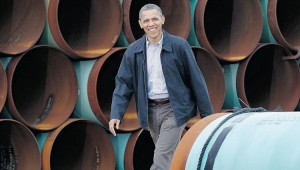
Obama visits the TransCanada Stillwater Pipe Yard in Cushing, Oklahoma
The American government is making no final conclusion yet on the proposed Keystone XL pipeline but says that the fate of the project will not materially impact the growth of Alberta’s oilsands.
TransCanada’s $7-billion pipeline project — proposed to ship oilsands crude to refineries on the United States Gulf Coast — has been in the crosshairs of environmentalists keen to halt oilsands expansion.
But the State Department’s draft Supplemental Environmental Impact Statement (SEIS) released Friday said Keystone will make little or no difference to the oilsands because of other transportation options — including rail — and the continued worldwide demand for oil.
“The approval or denial of any one crude oil transport project, including this proposed project, really remains unlikely to significantly impact the rate of development in the oilsands or the continued demand for heavy crude oil in the U.S.,” said the Assistant Secretary for Oceans and International Environmental and Scientific Affairs, Kerri-Ann Jones, in a conference call with reporters.
The report does say that oilsands crude is more greenhouse gas intensive, emitting 17 per cent more GHG on a life-cycle basis than the average barrel of oil refined in the U.S. in 2005.
The provincial and Canadian governments have pushed Keystone, citing it as a key project in opening new energy markets and easing the deep discount for oilsands crude that has led to a mammoth provincial revenue shortfall.
In a statement, Premier Alison Redford applauded the American government’s , “extensive, exacting and comprehensive review of potential environmental impacts from the project.”
“I welcome further progress toward a decision,” she said.
Jones said the release of the draft report will kick off a 45-day period to gather public input before the government prepares its final environmental impact statement. The project will then be subject to a final decision by President Barack Obama.
The report released Friday was drafted to not make a recommendation, said Jones.
“The purpose of this draft technical document is to be objective and to show all of the potential impacts and potential mitigation that could be moved forward is this project were to go forward. This paper does not come out one way or the other and make a decision what should happen with this project,” she said.
Travis Davies, spokesman for the Canadian Association of Petroleum Producers, said he’s not surprised at the report.
“It’s welcome. It’s obviously a step forward and hopefully provides a little impetus for the president making a decision on this,” he said. “It’s consistent with what the State Department found last time it went through it. If anything, it reaffirms the merits of the project.”
He said he agrees with the finding that the Keystone XL is not essential to allow expansion of the oilsands, noting that oil producers have been using “rail and truck and barge” to get around bottlenecks, despite higher costs of pipeline alternatives.
“What affects production here is demand. There’s strong demand in the Gulf (from heavy oil refineries), there are projects moving forward beyond Keystone XL.”
The State Department report drew heavy criticism from environmental organizations however.
The National Wildlife Federation called the study “fatally flawed.”
“If Keystone XL wouldn’t speed tarsands development, why are oil companies pouring millions into lobbying and political contributions to build it? By rejecting the Keystone XL tarsands pipeline, President Obama can keep billions of tons of climate-disrupting carbon pollution locked safely in the ground,” said NWF vice-president Jim Lyon in a news release.
Read the US State Department Keystone XL Draft Supplementary Environmental Impact Statement:
US State Department -Keystone XL Draft Supplementary Environmental Impact Statement by cheralddotcom